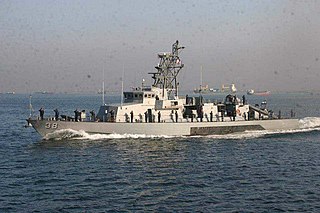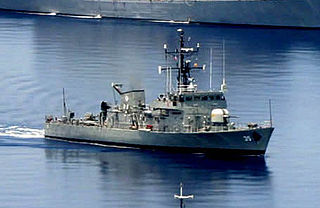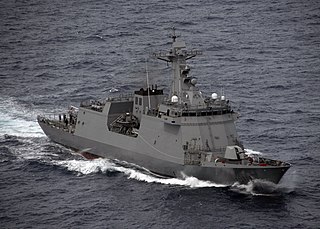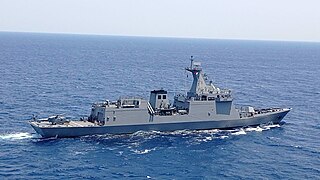
USS Harpers Ferry (LSD-49) is the lead ship of her class of landing ship dock of the United States Navy. This warship was named for the town of Harpers Ferry, West Virginia, which, because of the U.S. arsenal there, was an important location during the Civil War. USS Harpers Ferry is assigned to the Navy's "Amphibious Group 1". The homeport of Harpers Ferry is at San Diego County, California. Harpers Ferry was previously stationed at the American Naval Base in Sasebo, Nagasaki, Japan before she was relieved in 2011 by USS Germantown.

Vendémiaire is a Floréal-class frigate of the French Navy. She is the fifth ship of the class, and is named after Vendémiaire, the first month of the Republican Calendar. The ship was constructed at Saint-Nazaire, France, in 1992 and entered service in 1993. Vendémiaire is stationed in the French Pacific territories for patrol duties.

The Philippine Navy (PN) is the naval warfare service branch of the Armed Forces of the Philippines. It has an estimated strength of 24,500 active service personnel, including the 10,300-strong Philippine Marine Corps. It operates 82 combat vessels, 14 auxiliary vessels, 25 manned aircraft and 8 unmanned aerial vehicles. Tracing its roots from the Philippine Revolutionary Navy on May 20, 1898, while its modern foundations were created during the creation of the Offshore Patrol in February 9, 1939, the PN is currently responsible for naval warfare operations and maritime patrol missions within the Philippine Waters, as well as ensuring the protection of the Philippine's maritime interests, including the West Philippine Sea and Benham Rise.

The BRP Bacolod City (LS-550) is the lead ship of two Bacolod City class logistics support vessel, and is based on a helicopter capable variant of the US Army's Frank S. Besson class. She is also considered one of the most modern transport ships in the Philippine Navy, having been commissioned during the early 1990s. She was previously known as BRP Bacolod City (LC-550) prior to a classification change implemented by the Philippine Navy starting April 2016.

The BRP Dagupan City (LS-551) is the second and last ship of two Bacolod City class logistics support vessel, and is based on a helicopter capable variant of the US Army Frank S. Besson class. She is also considered one of the most modern transport ships in the Philippine Navy, having been commissioned during the early 1990s. She was previously known as BRP Dagupan City (LC-551) prior to a classification change implemented by the Philippine Navy starting April 2016

The BRP Rajah Humabon (PS-11) was a former destroyer escort of the United States Navy and a former frigate of the Philippine Navy. She was the last World War II-era destroyer escort/frigate active in her fleet, and one of the oldest active warships in the world, until 15 March 2018 when she was formally decommissioned after 75 years. She was one of three ex-USN Cannon-class destroyer escorts that served the Philippine Navy, the others being BRP Datu Sikatuna (PF-5/PS-77) and BRP Datu Kalantiaw (PS-76).

The BRP Quezon (PS-70) was one of two Rizal class ships in service with the Philippine Navy. She was formerly a USN Auk class minesweeper produced during World War II, and was later on classified as a patrol corvette protecting the vast waters of the Philippines.

BRP General Mariano Alvarez (PS-38) is the lead ship of its class of three coastal patrol ships currently in service with the Philippine Navy. She was the lead ship of the US Navy's Cyclone-class patrol ship prior to being transferred to the Philippine Navy.

The BRP Emilio Jacinto (PS-35) is the lead ship of the Jacinto-class corvettes currently assigned to the Offshore Combat Force of the Philippine Fleet. She is one of few ships in the Philippine Navy equipped with modern systems after the completion of combat, navigation and weapon systems upgrade of her class in August 2019. She was originally called HMS Peacock (P239) during her service with the Royal Navy.

BRP Miguel Malvar (PS-19) is the lead ship of the Miguel Malvar class of corvettes of the Philippine Navy. She was originally built as USS Brattleboro PCE(R)-852, a PCE(R)-848-class rescue patrol craft escort for the United States Navy during World War II. In 1966 she was transferred to South Vietnam for service in the Republic of Vietnam Navy as RVNS Ngọc Hồi (HQ-12). She was acquired by the Philippine Navy in April 1976 and later on commissioned as Miguel Malvar after Miguel Malvar y Carpio. The ship is in active service. Along with other World War II-era ships of the Philippine Navy, Miguel Malvar is one of the oldest active fighting ships in the world today.

BRP Cebu (PS-28) was a Miguel Malvar-class corvette of the Philippine Navy. She was originally built as USS PCE-881, a PCE-842-class patrol craft for the United States Navy during World War II and patrolled the Alaskan coast during that war. She was decommissioned from the U.S. Navy and transferred to the Philippine Navy in July 1948 and renamed RPS Cebu (E-28) after the Philippine province of the same name. The ship was decommissioned on 1 October 2019. Along with other World War II-era ships of the Philippine Navy, Cebu was considered one of the world's oldest fighting ships during her active service.

BRP Pangasinan (PS-31) was a Miguel Malvar-class corvette of the Philippine Navy. She was originally built as USS PCE-891, a PCE-842-class patrol craft for the United States Navy during World War II. She was decommissioned from the U.S. Navy and transferred to the Philippine Navy in July 1948 and renamed RPS Pangasinan (E-31).

Exercise Balikatan is the most prominent annual military exercise between the Philippines and the United States. The Tagalog word balikatan means "shoulder-to-shoulder". The exercises have been the cornerstone of Philippines–United States military relations since the closure of U.S. bases in the Philippines.

BRP Tarlac (LD-601) is the lead ship of her class of landing platform docks in service with the Philippine Navy. She is the second ship to be named after the Philippine province of Tarlac, one of the provinces considered to have significant involvement in the Philippine Revolution of independence against Spain.

BRP Gregorio del Pilar (PS-15) is the lead ship of her class of offshore patrol vessel of the Philippine Navy. She is the second ship to be named after Gregorio del Pilar, a Filipino revolutionary general known for his role at the Battle of Tirad Pass. She was originally designated as "PF-15" from 2012 to mid-2016. Then the Navy adopted a new code designation system and she was redesignated as "FF-15". In February 2019, the Navy downgraded the status of the entire class from frigate to patrol ship and redesignated her to "PS-15".

BRP Ramon Alcaraz (PS-16) is the second ship of the Gregorio del Pilar-class offshore patrol vessels of the Philippine Navy. From 1968 to 2012, she was known as USCGC Dallas and served the United States Coast Guard as a high endurance cutter. She was decommissioned on 30 March 2012 and acquired by the Philippines under the Excess Defense Articles and the Foreign Assistance Act.

BRP Andrés Bonifacio (PS-17) is the third ship of the Gregorio del Pilar-class offshore patrol vessels of the Philippine Navy. She is the second ship of the Philippine Navy to be named after Andrés Bonifacio, a Filipino revolutionary leader, regarded as the "Father of the Philippine Revolution" and one of the most influential national heroes of the Philippines.

BRP Jose Rizal (FF-150) is the lead ship of her class of guided missile frigates of the Philippine Navy. She is the first purpose-built frigate of the service, as its previous major warships were mostly obtained from retired patrol ships of other countries. She is also one of the navy's primary warships able to conduct multi-role operations, such as coastal patrol, anti-air and anti-submarine warfare.

BRP Antonio Luna (FF-151) is the second ship of the Jose Rizal-class of guided missile frigates in service with the Philippine Navy. She is able to conduct multi-role operations such anti-surface warfare (ASUW), anti-submarine warfare (ASW), and limited anti-air warfare (AAW). She is one of the service's primary warships until the introduction of new and more powerful contemporaries.

Toribio Dulinayan Adaci Jr. is a Philippine Navy vice admiral who serves as the 40th and current Flag Officer-in-Command (FOIC) of the Philippine Navy. Prior to his appointment, Adaci previously commanded the Naval Forces Western Mindanao from 2020 to 2022, the Naval Installation Command, and Fleet-Marine Ready Force.
























